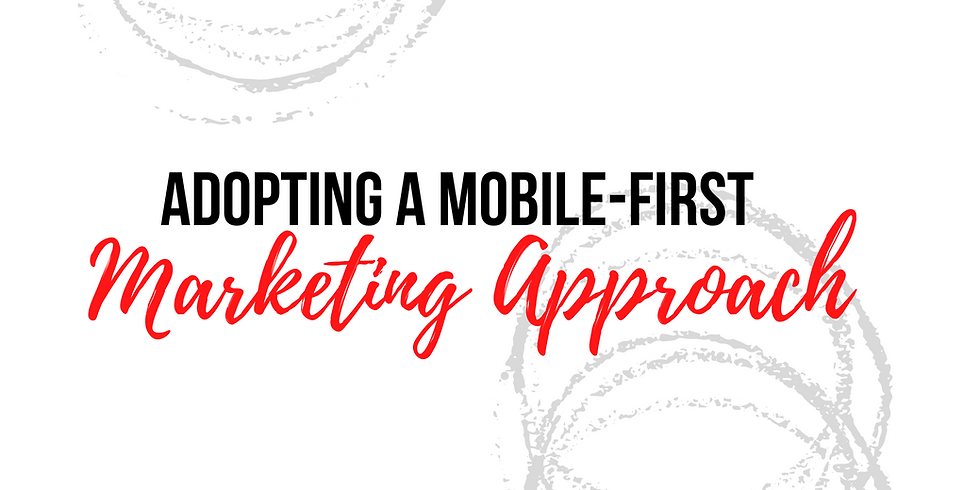How to Adopt a Mobile-First Marketing Approach for Your Business
- Paige Bethke
- Aug 15, 2023
- 4 min read

How do you feel about your website performance? Do you feel like your website checks all of the boxes but you're still disappointed when you check your analytics? An area that you may want to consider reevaluating is your web user's mobile experience. Today, more than half of web traffic comes from mobile accounts. A mobile-first approach has become increasingly important in the ever-evolving world of digital marketing. We recognize the significance of this paradigm shift and are here to guide you through the journey through 10 steps for adopting a mobile-first approach to your marketing strategy.
What is a Mobile-First Marketing Approach?
A mobile-first approach to marketing acknowledges the dominant role that mobile devices play in today's consumer behavior. Essentially, a mobile-first approach flips the process of web design. Instead of designing for desktop screens and then adapting for mobile, it involves crafting content, design, and functionality specifically for mobile devices to ensure seamless navigation, engagement, and experience for your mobile users.
Why a Mobile-First Approach Matters
A mobile-first experience may be what your marketing approach has been missing. The rise of mobile devices has reshaped consumer behavior and digital interactions. Here's why adopting a mobile-first approach matters for your small business:
Higher Consumer Expectations: People expect your pages to be fast-loading and easy-to-navigate. Failing to meet these expectations can result in a higher bounce rate and missed customers.
Google Prioritizes Mobile SEO: When searching on Google, mobile-friendly websites appear higher up in search results. A mobile-first approach can improve your search engine optimization (SEO) rankings which will drive more traffic to your pages and increase your site's visibility.
Boost in Local Search: Mobile devices are often used for local searches and quick decision-making. A mobile-first strategy helps you attract local customers and boost marketing opportunities in your area.
Opportunity for Immediate Value: The best way to gain loyal customers is to become their go-to source of valuable information. Today's consumers are always looking for quick solutions from mobile search. A mobile-first approach allows you to capture these moments and become that source of immediate value.
10 Steps to Adopt a Mobile-First Approach:
Ready to enhance your customer's mobile experience?
Here's how you can start transitioning towards a mobile-first approach today:
Step 1: Audit Your Current Website
The first thing you want to do is to evaluate how your current website performs for a mobile user. Check your site's mobile responsiveness, loading speed, and user interface. For more information on how to do this, keep reading.
Step 2: Tidy Up Your Mobile Design
When designing your website from a mobile perspective, remember that less is more. Aim to achieve a clean, intuitive layout that won't look cluttered on a smaller screen. Consider mobile-friendly navigation menus and concise content.
Step 3: Optimize Page Speed
As mentioned above, mobile users expect swift experiences. How can you improve your site's speed? Compress your images, minimize the amount of complex code, and learn how to best manage your cache to reduce each page's load time.
Step 4: Content Optimization
Tailor your content for the mobile user. Think about it... people on their phones are probably multitasking. Make your content easy to digest: use concise headlines, bullet points, and legible fonts so that someone can read it while they're walking to work or standing in line at Starbucks.
Step 5: Create Mobile-Friendly Forms
Does your business collect user data using forms? If so, make sure these forms function well with mobile devices. One simple way to do this is by keeping form fields minimal and straightforward.
Step 6: Evaluate your mobile SEO
You know how important SEO is right? Optimize your website for mobile search engines. Use responsive design and focus on local SEO strategies. To learn more about SEO, check out this blog post.
Step 7: Test your analytics
Search your website on various mobile devices and browsers to identify any issues that may be impacting your mobile users. Use analytics tools to track user behavior and make necessary improvements.
Step 8: Explore Mobile-Focused Tools
Enhance your mobile user's experience by tailoring your pages for them: add tools like click-to-call buttons and location-based services. Even ensuring that your ad formats are set up for mobile could help to enhance your engagement.
Step 9: Consider a Mobile App
Depending on your business, your customer may benefit from a mobile app instead of utilizing your company's website. Consider creating an app if you are in industry where this makes sense: retail, tourism, e-commerce, etc.
Step 10: Get User Feedback
The best way to ensure your customer is having a positive mobile experience is to ask them! Get feedback from your mobile users and be sure to take their suggestions to heart by incorporating them into your site.
Embrace the Future of Marketing
Guys, listen up. This mobile-first thing is not just a trend but absolutely necessary from a strategic standpoint. The businesses that are able to prioritize mobile experiences for their consumers to ensure that they are always connected will have a strategic advantage above the competition. At MegoMedia, we can help you harness the power of a mobile-first strategy to keep your target audience reliant on your business for years to come. Contact us today to embark on the journey towards a mobile-first marketing approach. Your success is just a click away.




Comments